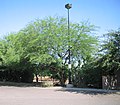Acacia berlandieri: Difference between revisions
Jump to navigation
Jump to search
No edit summary |
No edit summary |
||
| Line 1: | Line 1: | ||
{{SPlantbox | {{SPlantbox | ||
|familia=Fabaceae | |familia=Fabaceae | ||
|genus=Acacia | |genus=Acacia | ||
|species=berlandieri | |species=berlandieri | ||
|common_name=Berlandier's acacia, Guajillo, Plains acacia | |common_name=Berlandier's acacia, Guajillo, Plains acacia | ||
|name_ref=Flora - A Gardener's Encyclopedia | |name_ref=Flora - A Gardener's Encyclopedia | ||
| Line 27: | Line 27: | ||
|usda_ref=Flora - A Gardener's Encyclopedia | |usda_ref=Flora - A Gardener's Encyclopedia | ||
|max_zone=9 | |max_zone=9 | ||
|image= | |sunset_zones=12, 13, 26-29 | ||
|image_width= | |image=Acacia berlandieri branch.jpg | ||
|image_width=220 | |||
}} | }} | ||
'''''Acacia berlandieri''''' ('''Berlandier Acacia''', '''Guajillo Acacia''', '''guajillo''', '''huajillo''') is a [[shrub]] native to the [[Southwestern United States]] that belongs to the [[Mimosaceae]] (wattle family). It grows 1m to 5m tall, with [[blossom]]s that are spherical and white, occurring from February through April.<ref name "npin">[http://wildflower.utexas.edu/plants/result.php?id_plant=ACBE University of Texas Native Plant Information Network]</ref> The ''berlandieri'' epithet comes from the name of [[Jean-Louis Berlandier]]<ref> | '''''Acacia berlandieri''''' ('''Berlandier Acacia''', '''Guajillo Acacia''', '''guajillo''', '''huajillo''') is a [[shrub]] native to the [[Southwestern United States]] that belongs to the [[Mimosaceae]] (wattle family). It grows 1m to 5m tall, with [[blossom]]s that are spherical and white, occurring from February through April.<ref name "npin">[http://wildflower.utexas.edu/plants/result.php?id_plant=ACBE University of Texas Native Plant Information Network]</ref> The ''berlandieri'' epithet comes from the name of [[Jean-Louis Berlandier]]<ref> | ||
{{cite book | {{cite book | ||
| Line 59: | Line 53: | ||
| accessdate = 2007-04-01 | | accessdate = 2007-04-01 | ||
| doi =10.1016/S0031-9422(97)00240-9}}</ref> | | doi =10.1016/S0031-9422(97)00240-9}}</ref> | ||
==Cultivation== | ==Cultivation== | ||
== | ===Propagation=== | ||
== | ===Pests and diseases=== | ||
== | ==Varieties== | ||
== | ==Gallery== | ||
<gallery perrow=5> | |||
Image:Acacia-berlandieri-flowers.jpg|''Acacia berlandieri'' Foliage and Flowers | |||
Image:Acacia-berlandieri-habit.jpg|''Acacia berlandieri'' Tree | |||
Image:Acacia-berlandieri-bark.jpg|''Acacia berlandieri'' Bark | |||
Image:Acacia-berlandieri-pods.jpg|''Acacia berlandieri'' Flowers and Seed Pods | |||
Image:Acacia berlandieri seeds.jpg|''Acacia berlandieri'' Seeds | |||
</gallery> | |||
==References== | |||
<references/> | <references/> | ||
<!--- xxxxx *Flora: The Gardener's Bible, by Sean Hogan. Global Book Publishing, 2003. ISBN 0881925381 --> | |||
<!--- xxxxx *American Horticultural Society: A-Z Encyclopedia of Garden Plants, by Christopher Brickell, Judith D. Zuk. 1996. ISBN 0789419432 --> | |||
<!--- xxxxx *Sunset National Garden Book. Sunset Books, Inc., 1997. ISBN 0376038608 --> | |||
== External links == | ==External links== | ||
* | *{{wplink}} | ||
{{ | |||
{{stub}} | |||
__NOTOC__ | |||
Latest revision as of 00:47, 2 July 2010
| Acacia berlandieri subsp. var. | Berlandier's acacia, Guajillo, Plains acacia | |||||||||||||||||||||||||||||||||||||||||||||||||||||||
|---|---|---|---|---|---|---|---|---|---|---|---|---|---|---|---|---|---|---|---|---|---|---|---|---|---|---|---|---|---|---|---|---|---|---|---|---|---|---|---|---|---|---|---|---|---|---|---|---|---|---|---|---|---|---|---|---|

|
|
| ||||||||||||||||||||||||||||||||||||||||||||||||||||||
| ||||||||||||||||||||||||||||||||||||||||||||||||||||||||
Acacia berlandieri (Berlandier Acacia, Guajillo Acacia, guajillo, huajillo) is a shrub native to the Southwestern United States that belongs to the Mimosaceae (wattle family). It grows 1m to 5m tall, with blossoms that are spherical and white, occurring from February through April.[1] The berlandieri epithet comes from the name of Jean-Louis Berlandier[2], a French naturalist who studied wildlife native to Texas and Mexico. A. berlandieri contains a wide variety of alkaloids and has been known to cause toxic reactions in domestic animals such as goats.[3]
Cultivation
Propagation
Pests and diseases
Varieties
Gallery
-
Acacia berlandieri Foliage and Flowers
-
Acacia berlandieri Tree
-
Acacia berlandieri Bark
-
Acacia berlandieri Flowers and Seed Pods
-
Acacia berlandieri Seeds
References
- ↑ University of Texas Native Plant Information Network
- ↑ Holloway, Joel Ellis (2005). A Dictionary of Common Wildflowers of Texas & the Southern Great Plains. Texas Christian University Press. ISBN 354063293X.
- ↑ Clement, Beverly A.; Christina M. Goff and T. David A. Forbes (September 1997). "Toxic amines and alkaloids from Acacia berlandieri". Phytochemistry (Elsevier) 46 (2): 249–254. doi:10.1016/S0031-9422(97)00240-9. http://www.sciencedirect.com/science?_ob=ArticleURL&_udi=B6TH7-3SCB6WX-1N&_user=10&_coverDate=09%2F30%2F1997&_rdoc=1&_fmt=&_orig=search&_sort=d&view=c&_acct=C000050221&_version=1&_urlVersion=0&_userid=10&md5=b215a5ead4e2fc6cc27a4cf30ced3f5e. Retrieved 2007-04-01.
External links
- w:Acacia berlandieri. Some of the material on this page may be from Wikipedia, under the Creative Commons license.
- Acacia berlandieri QR Code (Size 50, 100, 200, 500)




